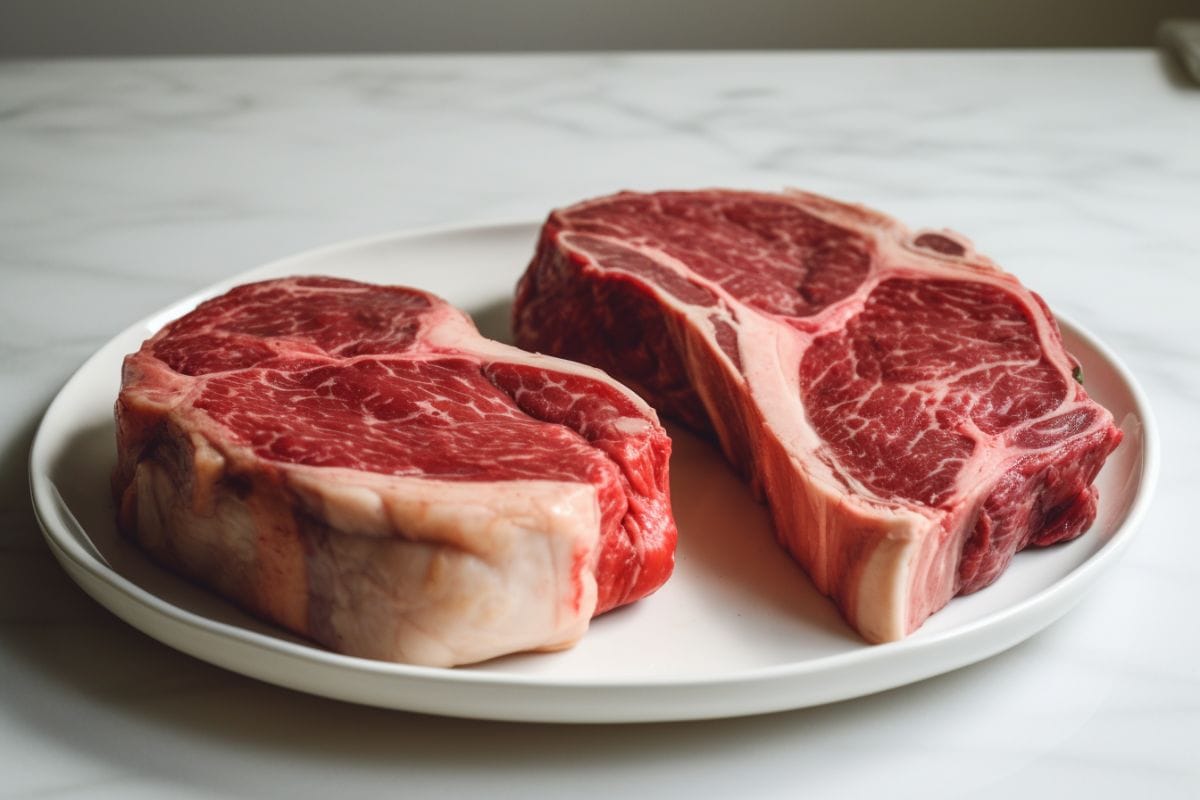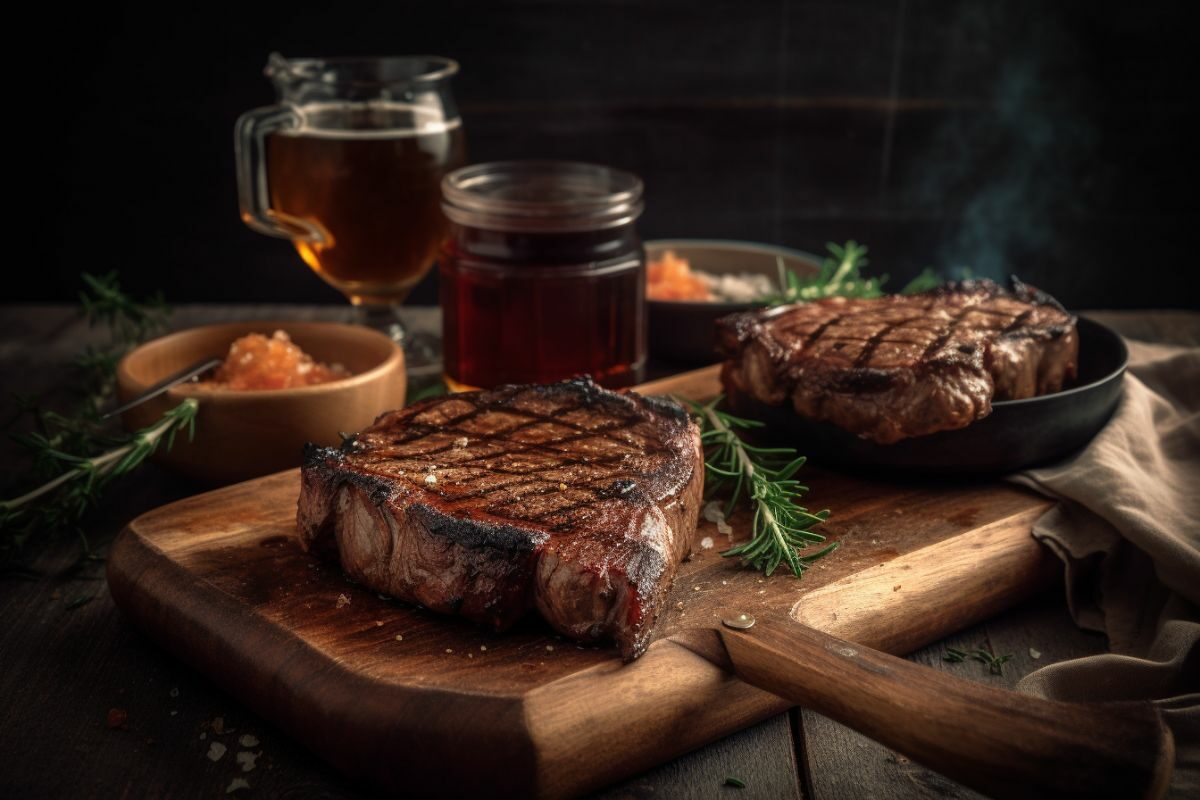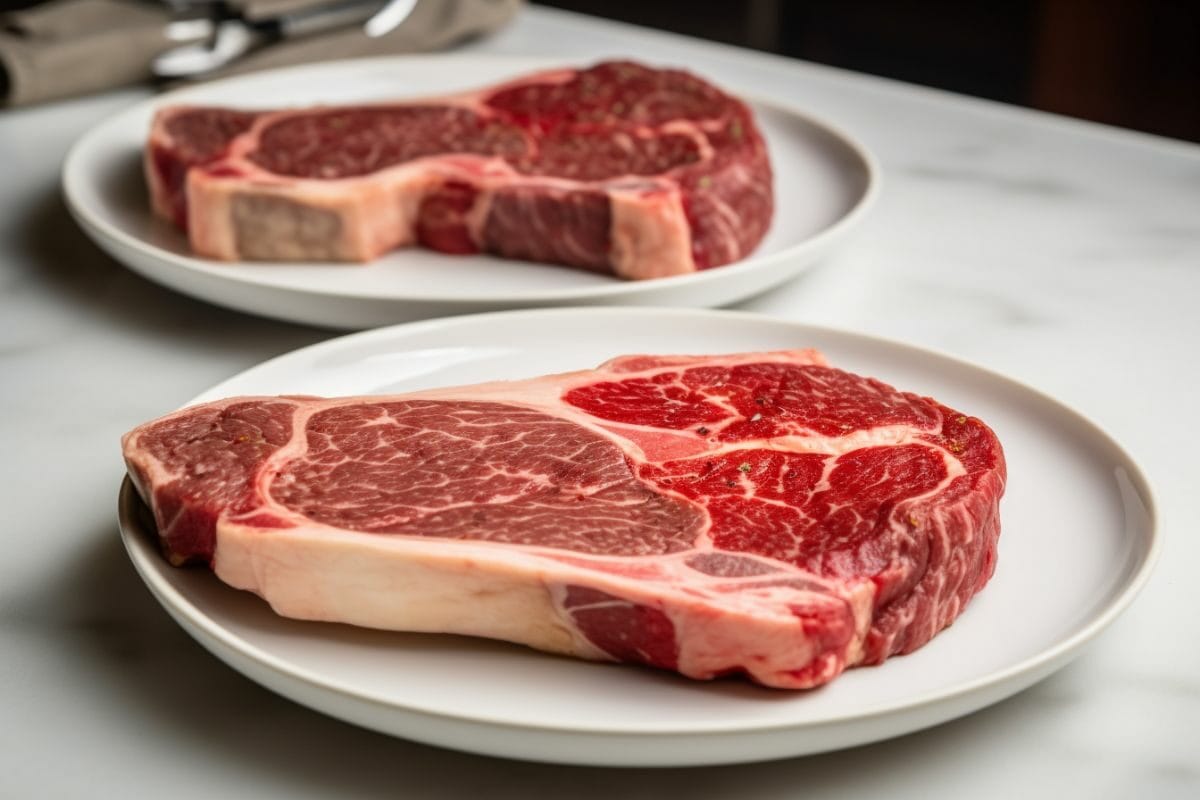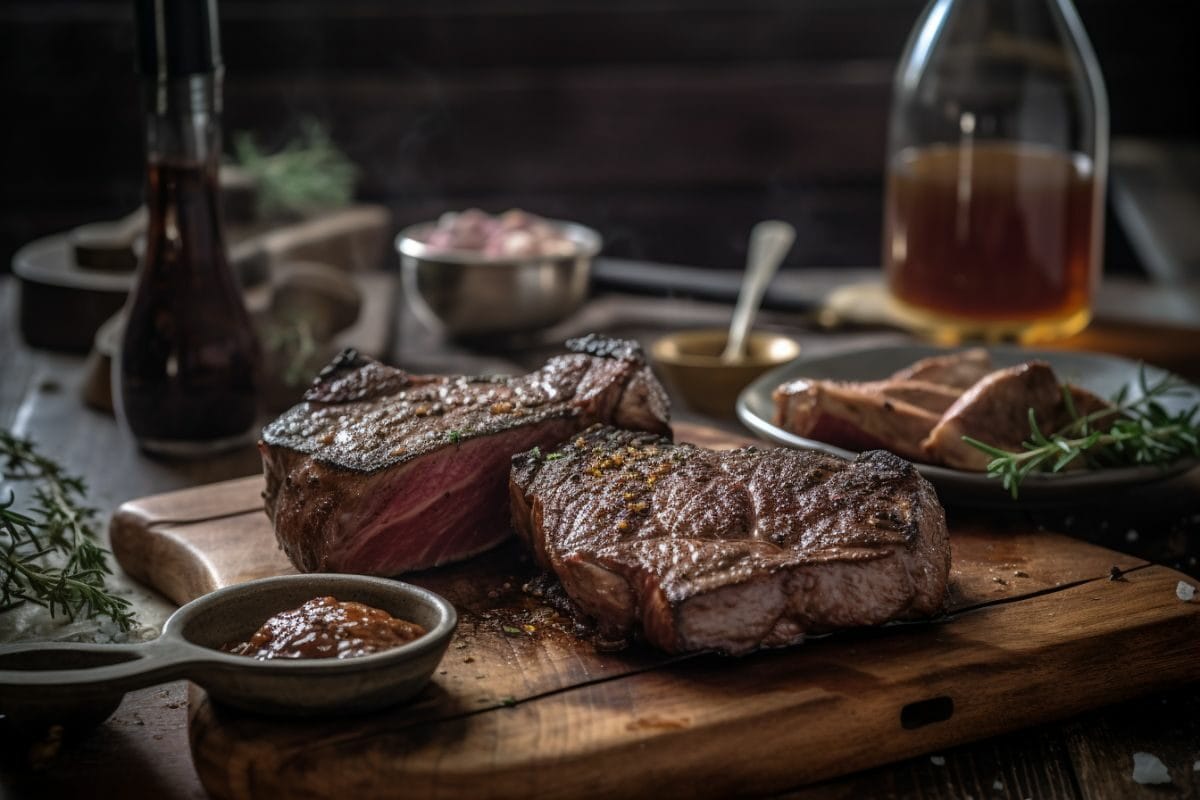I like ribeye more than New York strip, but taste is subjective. Ribeye and New York strip steak are similar because they’re both from the back of the cow. They’re different cuts from the same muscle of the steer, the longissimus dorsi. Ribeye is packed with beefy flavor, while the NY strip is slightly more tender.
I have a confession: grilled steak is my kryptonite. A perfectly grilled ribeye would be my “last meal” food. Whenever I have friends and family around, and I want to “wow” them, I grab some strip steaks or some ribeyes. I think both cuts are divine. To do justice to the ribeyes vs. New York strip debate, I grilled up both in a side-by-side showdown. I’ll show you the best way to grill them. Let’s crown a steak king of planet beef!

Ribeye steaks are the choice for many pit masters, including me. Strip steak is also excellent – if you grill some up, I’ll happily eat it. Both cuts are usually around the same price. They also come from almost the same part of the cow. The ribeye is closer to the head of the steer, while the strip comes from further back.
Strip steak is slightly more tender than ribeye. It also has a fat cap (ribeye doesn’t) that I trim to ¼” before cooking.
The ribeye steak has a more robust flavor. It’s more richly marbled – if you like leaner meat, go for the NY strip loin. Ribeyes often have large chunks of thick white fat that need to be trimmed before cooking.
The New York Strip is also called a Kansas City strip, or strip steak. It’s slightly more tender than a ribeye but isn’t as beefy in flavor.
The cut comes from just behind the ribs of a cow, further back than the ribeye. It’s a great cut of beef that’s perfect for your grill.
The New York strip steak comes from a muscle of the cow that does little work. Muscles that animals don’t use frequently tend to be very tender, and the NY strip is no exception. It’s a great cut of beef.
This loin steak doesn’t have quite as much intramuscular fat or marbling as a ribeye. Because they aren’t quite as finely marbled, they don’t pack quite the punch of flavor that ribeyes do. Hold a strip loin next to a ribeye, and you can see that this is a slightly leaner cut, with fewer fine white lines of fat.
It likely has a fat cap on top. The fat cap will not render – trim it down to around ¼” before cooking. For an elegant presentation, trim it off before serving.
Related Reading

Ribeyes are also called beauty steaks, market steaks, Delmonicos, Spencer steaks, and Scotch fillets. Tomahawk steaks are massive ribeyes with the bone in them. Prime rib is a whole roast of ribeye steaks.
The ribeye steak is found more in the middle/front part of the cow (the upper rib cage). It comes from the rib primal before the short loin, where the strip loin is taken.
I’m going to let you in on a pit boss secret. The cap of meat at the head of the ribeye is called the “spinalis” (it’s the name of the muscle). It is incredibly tender and rich, and I think it’s the best bite of meat on the entire cow. If you’re ribeye shopping, look for steaks with a large spinalis.
The further toward the head of the steer you travel, the bigger the spinalis gets. There’s some fat that separates the rest of the spinalis from the rest of the ribeye. The grain of the spinalis meat is coarser. Here’s a video to help you identify it.
Related Reading
Both the ribeye and the NY strip steak are similarly priced.
Ribeyes can be a little more expensive. It all depends on where you live and the grocery store you’re shopping at.
Strip steak and ribeye are typically the second most costly steaks after the tenderloin (aka filet mignon). So we’re dealing with premium steaks.
For this comparison, I bought a 12-ounce Choice ribeye steak that was going for $12 a pound. I scored a 12-ounce New York strip loin, also Choice, for the same price.
They go on sale periodically at grocery stores. Shop around for good prices.
Related Reading
There are three grades of steak that the USDA uses. They are Prime, Choice, and Select, with Prime being the best and Select being the most pedestrian. Select steaks are good. Prime steaks are transcendent.
Besides USDA grades of steak, there’s a newer type of beef on the market known as Wagyu. True Wagyu is mostly only available in Japan. You’ve probably heard of Kobe beef. It’s a type of Japanese Wagyu that comes from a specific breed of cattle.
American Wagyu steak is a blend of Japanese cattle and American cattle and has taken the BBQ community by storm in recent years. Wagyu boasts incredible marbling and a hefty price tag. I think everyone should try Wagyu at least once. You have my permission to splurge. It might just change your life.

Time for the rubber to meet the road (pun intended). Let’s get to cooking!
Today, I will be grilling both a Ribeye steak and a New York strip steak to find out which is better. Not all heroes wear capes. The sacrifices I make for our readers!
You need a little flavor on the meat before smoking. I dry-brined these steaks in the morning and cooked them up at night. To dry brine, add ½ teaspoon of Kosher salt per pound of meat at least an hour or two before cooking. This helps the meat retain juices and improves the taste.
I applied the entire rub to the meat along with the salt. Leave the steaks in the refrigerator uncovered. Here’s what I used for two 12 oz steaks:
That’s it! Some pitmasters like to add other seasonings like paprika, Lawry’s seasoned salt, or their favorite rub. I like to go easy with the crazy spices and let that grilled beefy goodness shine through, but you do you!
The most important thing I want the rub to do is enhance the rich flavor of the beef. The garlic powder and salt and pepper will boost the beef flavors.
Before cooking, I started with the strip loin. It has a hard fat cap on top. I trimmed it to around ¼” thick. After carving the fat cap, I put seasonings on every side. I patted the seasonings gently with my hand.
Ribeye doesn’t have a fat cap that needs trimming, but if it has any large areas of thick white fat, remove them. I cut a few chunks off of mine, then applied the seasoning to every side.
Note: You don’t need to marinade the rib eye or the strip loin. They’re tender cuts of meat that will end up juicy and tender. I don’t know of any competition teams or good steakhouses that marinate these cuts.
I cooked the strip loin and ribeye hot and fast on my charcoal grill. I like to use my Kamado Joe Big Joe. Kamado cookers can get scorchingly hot, which is perfect for skinny steaks.
Once the charcoal was lit up, I added a handful of hickory wood chunks. You can use hickory, oak, apple, or whatever you like. Just don’t add too much. Chips work, too. You’re not smoking the meat, but the chunks will add a wood-fired flavor to the steaks. Get your grill as hot as you can – 500°F or more is great. Most prime steakhouses cook at temperatures above 700°F.
I placed the meat on top of the grill grates and cooked them for around 2 to 3 minutes a side. Then I flipped the steaks over and grilled the other side for 2 to 3 minutes.
I cooked these steaks to 125°F internal temperature, which is medium-rare.
If you like your steaks cooked to medium, let them cook another minute or so per side. Medium steaks have an internal temperature of 135°F.
The USDA recommends cooking whole cuts of beef to 145°F to prevent foodborne illness. I recommend cooking to medium-rare for sublime tenderness and flavor. Most steak fanatics and steakhouses agree with me, but cook the steak to whatever doneness temperature you like to eat it.
I don’t rest steak. Any drippings lost are mopped up when you dredge the cut steak through them, and the crust tastes best when hot out of the grill. Time to dig in.
Related Reading

Both steaks were *chef’s kiss.* Absolutely phenomenal and cooked to perfection. The strip loin had a beautiful sear and killer grill marks. The meat was brimming with juice thanks to the dry brine.
And when I sliced into the ribeye, there was the same perfection. Beautiful crust and packed with beefy flavor!
The two cuts were neck and neck for which was “better.” While I slightly preferred the ribeye, I’ll be honest: I wouldn’t kick the strip steak out of bed. The “ultimate bite” of the spinalis on the ribeye pushed it to the top spot for me. It really is incredibly tender and jammed with flavor.
Related Reading
As you can see from the ribeye vs. New York strip steak comparison, choosing between the two comes down to personal preference. Ribeye has a bit more flavor, while the NY strip is slightly more tender. If either cut is significantly cheaper, go with that one. You really can’t go wrong choosing either one.
There you have it, the ultimate steak showdown. I hope you enjoyed reading this as much as I enjoyed my side-by-side tasting. Happy grilling!